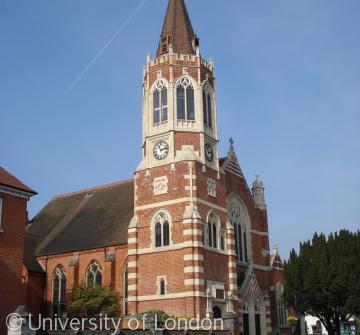Friar Park, Henley

After a difficult period in the early-to-mid 19th century, Henley's fortunes revived in the late Victorian and Edwardian period, as the railway and the Regatta helped turn it into a fashionable social, leisure and commuting centre close to London. This resurrection in Henley's fortunes was reflected in renewed building and suburban expansion, as confidence and prosperity returned and local builders and developers recognised the opportunities. At a higher social level, the building of villas and larger houses spilled beyond the southern suburbs and the Fair Mile into the surrounding countryside. The most spectacular example is Friar Park on the town's western edge, built c.1890 as a luxurious weekend retreat for the London solicitor Frank Crisp. Designed by the little-known architect M. Clarke Edwards, the house is an architectural fantasy in red brick, stone and terracotta, mixing English, French and Flemish motifs in lavish, undisciplined profusion. But the house achieved its greatest fame (and even notoriety) on account of its 62-acre grounds, landscaped in fantastical style with topiary, 25 glasshouses, a gnome-filled grotto, and a rock garden overlooked by a miniature Matterhorn. The gardens reflected Crisp's scientific interest in horticulture as well as a more romantic medievalism. They also suggest a lively sense of fun, which is evident in the carved terracotta friars scattered around the house. The name Friar Park preceded Crisp's purchase, and derived from a local field-name before the area was built on: there is no historical connection with friars or any other religious group. (Read about the earlier house.) .
Philanthropic residents like Crisp at Friar Park or the Mairs at Phyllis Court engaged with the town in various ways, sometimes throwing their houses and gardens open on special occasions. In 1895, for instance, the Horticultural Society held its annual show in the grounds of Friar Park. Crisp also supported (and perhaps influenced the designs for) the new Congregationalist church of 1907, which is architecturally a cousin of Friar Park, its lantern-like tower still announcing the approach to the town from the Reading direction. When not in London, Crisp continued to live at Friar Park until his death in 1919. The next owner was the financier and Chinese art connoisseur Sir Percival David (1892-1964), who moved away following his divorce in 1953. His former wife stayed on at 'Friar Park End', remodelled from the coach house and stable courtyard. The main house was acquired by a religious order, the Salesian Sisters of St John Bosco, who were still there in 1969. Soon after, Friar Park was bought by the former Beatle George Harrison. Harrison took a close interest in Henley, involving himself in local conservation issues, and embarking on major restoration programmes at Friar Park. The Crisp connection was celebrated in Harrison's song 'The Ballad Of Sir Frankie Crisp (Let It Roll)', on the 1970 album All Things Must Pass. The sleeve features a photograph of Harrison at Friar Park, surrounded by ornamental stone gnomes from the gardens. Books relevant to Friar Park include: F. Crisp, Guide to Friar Park (1914) Country Life, 5 Aug. 1905, 162-7 ('The Alpine Garden: Friar Park, Henley, the Residence of Mr Frank Crisp') B. Elliott, Victorian Gardens (1986) .
Content generated during research for the paperback book 'Henley-on-Thames: Town, Trade and River' (ISBN 13 : 978-1-86077-554-3) for the England's Past for Everyone series




